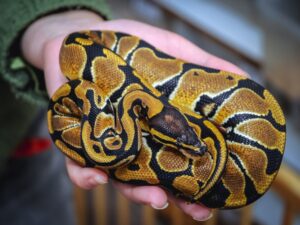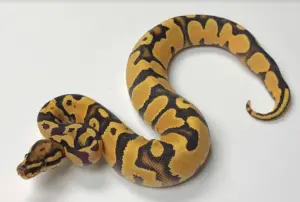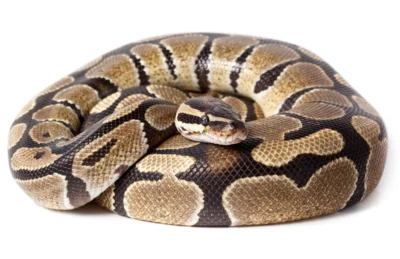Among the myriad considerations for responsible reptile ownership, understanding the environmental needs of specific species is paramount. When it comes to the care of ball pythons (Python regius), a popular choice among reptile enthusiasts, questions often arise regarding their lighting requirements. One such query that frequently emerges is: ‘Do ball pythons need UVB?
Ball pythons, unlike some other reptile species, do not require UVB lighting for their survival. In their natural habitat, ball pythons are primarily nocturnal and spend much of their time hiding in burrows or under foliage, avoiding direct sunlight. They derive their vitamin D3 from their diet rather than from UVB exposure.
However, providing a low level of UVB lighting can still offer some benefits, such as aiding in the synthesis of vitamin D3 and promoting natural behaviors. While UVB lighting is not essential for ball pythons, providing a well-rounded and enriching environment can contribute to their overall health and well-being.
Understanding Ball Python Habitat

Understanding the habitat requirements of ball pythons is crucial for their well-being in captivity. Here’s a breakdown:
- Enclosure: Ball pythons need an enclosure that mimics their natural habitat. A glass terrarium or a plastic reptile enclosure with secure ventilation is ideal. The enclosure should be escape-proof, as ball pythons are known to be escape artists.
- Size: Enclosures for ball pythons should be appropriately sized. A general rule is that the enclosure’s length should be at least equal to the snake’s length, and the width should be around one-third to one-half of the snake’s length. A young ball python can start in a smaller enclosure and then be upgraded as it grows.
- Substrate: Choosing the right substrate is important for maintaining humidity levels and providing a comfortable environment. Popular substrate options include aspen shavings, cypress mulch, coconut husk, or paper towels. Avoid substrates that can cause respiratory issues, such as cedar or pine.
- Temperature: Ball pythons require a temperature gradient in their enclosure. One side should have a basking spot with a temperature of around 88-92°F (31-33°C), while the other side should be cooler, around 75-80°F (24-27°C). This allows the snake to thermoregulate by moving between the warmer and cooler areas.
- Humidity: Maintaining proper humidity levels is crucial for the health of ball pythons, especially during shedding. Humidity should be kept between 50-60% but increased to 60-70% during shedding. This can be achieved by misting the enclosure, providing a humid hide, or using a substrate that retains moisture.
- Hiding spots: Ball pythons are secretive animals and require multiple hiding spots in their enclosure. These hides should be snug and secure to help the snake feel safe and reduce stress. Place hides on both the warm and cool sides of the enclosure.
- Lighting: Ball pythons are nocturnal and do not require UVB lighting like some reptiles. However, providing a regular light cycle of 10-12 hours of light and 12-14 hours of darkness can help regulate their internal clock.
- Water: Always provide a clean water bowl large enough for the snake to soak in if desired. Change the water regularly to prevent bacterial growth and ensure it’s always fresh.
By creating an environment that closely mimics the ball python’s natural habitat, you can help ensure its health and well-being in captivity. Regular monitoring of temperature, humidity, and cleanliness is essential for maintaining optimal conditions.
Do ball pythons need a heat lamp?
Ball pythons do require supplemental heat to maintain proper body temperature and aid in digestion, especially since they are ectothermic (cold-blooded) animals. While a heat lamp is one option for providing this heat, it’s not the only choice. Here are a few options for providing heat for your ball python:
- Heat lamp: A heat lamp, such as a ceramic heat emitter (CHE) or a red incandescent bulb, can be used to create a basking spot in the enclosure. This basking spot should be positioned at one end of the enclosure and maintained at a temperature of around 88-92°F (31-33°C).
- Under tank heater (UTH): A UTH is a heating pad that adheres to the bottom or side of the enclosure. This can provide gentle heat from below, mimicking the warmth of the ground in the wild. It’s essential to use a thermostat with a UTH to regulate the temperature and prevent overheating.
- Heat tape or heat cable: Similar to a UTH, heat tape or heat cable can be installed underneath the enclosure substrate to provide bottom heat. Again, a thermostat should be used to control the temperature.
- Radiant heat panels: Radiant heat panels are mounted on the ceiling of the enclosure and emit infrared heat. They provide a more uniform heat source compared to heat lamps and can be a good option for larger enclosures.
The choice of heating source depends on factors such as the size of the enclosure, ambient room temperature, and the specific needs of your ball python. It’s essential to monitor temperatures closely with a thermometer or thermostat to ensure they remain within the appropriate range.
The Importance of UVB Light for Ball Pythons
UVB light is essential for the health and well-being of ball pythons, as it plays a crucial role in their overall physiological processes. Here’s why UVB light is important for ball pythons:
- Calcium Metabolism: UVB light is necessary for the synthesis of vitamin D3 in the skin of reptiles, including ball pythons. When ball pythons are exposed to UVB light, the vitamin D3 produced helps in the absorption of calcium from their diet. Calcium is crucial for maintaining healthy bones, muscle function, and overall growth and development.
- Prevention of Metabolic Bone Disease (MBD): Metabolic bone disease is a common and serious health concern in reptiles, including ball pythons. It occurs when there is a deficiency of calcium and/or vitamin D3 in their diet or environment. UVB light helps prevent MBD by enabling the proper absorption and utilization of calcium, thus ensuring the development of strong and healthy bones.
- Regulation of Behavioral and Physiological Processes: UVB light not only influences calcium metabolism but also plays a role in regulating various behavioral and physiological processes in ball pythons. Adequate exposure to UVB light helps maintain their natural circadian rhythm, appetite, and reproductive behaviors.
- Enhancement of Skin and Shedding: Proper exposure to UVB light can contribute to the maintenance of healthy skin in ball pythons. It can aid in shedding by promoting the production of keratin, the protein component of skin, which allows for a smooth and complete shedding process. Inadequate exposure to UVB light may lead to retained shed and subsequent skin problems.
- Overall Health and Immunity: UVB light exposure is linked to the overall health and immunity of ball pythons. Vitamin D3, synthesized in response to UVB exposure, not only facilitates calcium absorption but also supports immune function, helping ball pythons resist infections and diseases.
It’s important for ball python owners to provide UVB lighting in their enclosures to mimic the natural sunlight that ball pythons would receive in their native habitat. However, it’s crucial to ensure that the UVB light source is of the appropriate intensity and spectrum for reptiles, and that ball pythons have access to both UVB light and areas of shade within their enclosure to regulate their exposure according to their needs.
UVB Requirements for Ball Pythons

Ball pythons, like many reptiles, require UVB light for their health, particularly for proper calcium metabolism. However, the UVB requirements for ball pythons are not as high as those for some other reptile species, such as diurnal lizards or turtles, which are more active in basking under direct sunlight.
While ball pythons do benefit from UVB exposure, they are primarily nocturnal animals and spend much of their time hiding in shelters during the day. Therefore, they do not require as intense or prolonged UVB exposure as diurnal species.
When providing UVB lighting for ball pythons, it’s essential to consider the following:
- Low to Moderate UVB Levels: Ball pythons typically require UVB lighting with low to moderate levels of UVB radiation. Exposing them to excessive UVB radiation can cause stress and potential health issues.
- Proper Spectrum: Ensure that the UVB bulb you choose emits the appropriate spectrum of light for reptiles, typically in the range of 290 to 320 nanometers. This spectrum is essential for the synthesis of vitamin D3 in their skin.
- Photoperiod: While ball pythons do not require prolonged exposure to UVB light, providing a natural day-night cycle with a photoperiod of around 12 hours of light and 12 hours of darkness can help regulate their biological rhythms.
- Access to Shade: Even though they benefit from UVB exposure, ball pythons should also have access to areas within their enclosure where they can retreat to shade or darkness if they prefer. This allows them to regulate their exposure to UVB light based on their needs.
- Supplementation: In addition to UVB lighting, ensuring that ball pythons receive adequate dietary calcium and vitamin D3 supplementation is crucial for their overall health. This is especially important for captive ball pythons whose UVB exposure may be limited compared to wild counterparts.
Overall, while UVB lighting is beneficial for ball pythons, it’s essential to provide it in moderation and in conjunction with other aspects of their care, such as proper diet, temperature, and humidity levels, to ensure their well-being in captivity.
Providing UVB for Ball Pythons: Best Practices
Providing UVB for ball pythons involves careful consideration of various factors to ensure their health and well-being. Here are some best practices for offering UVB lighting to ball pythons:
- Selecting the Right UVB Bulb: Choose a UVB bulb specifically designed for reptiles, preferably one that emits UVB radiation in the appropriate spectrum (around 290 to 320 nanometers). Compact fluorescent or linear fluorescent UVB bulbs are commonly used for reptile enclosures.
- Determine the Correct Wattage and Distance: Follow the manufacturer’s guidelines to determine the appropriate wattage and distance for the UVB bulb. Ensure that the UVB output is sufficient for your enclosure size and that the bulb is positioned at the correct distance from basking spots.
- Provide Proper Photoperiod: Establish a natural day-night cycle with a photoperiod of around 12 hours of light and 12 hours of darkness. This helps regulate the ball python’s circadian rhythm and provides a natural lighting schedule.
- Offer Access to Shade: While ball pythons benefit from UVB exposure, they should also have access to shaded areas within their enclosure where they can retreat if they prefer. This allows them to regulate their UVB exposure based on their needs.
- Monitor Temperature and Humidity: Ensure that the temperature and humidity levels in the enclosure are appropriate for ball pythons. UVB bulbs can contribute to increasing temperatures in the enclosure, so monitor and adjust as needed to maintain optimal conditions.
- Regularly Replace UVB Bulbs: UVB bulbs degrade over time, even if they still emit visible light. Replace UVB bulbs according to the manufacturer’s recommendations to ensure that your ball python continues to receive adequate UVB exposure.
- Supplement Diet as Needed: While UVB exposure aids in calcium metabolism, it’s essential to provide a well-balanced diet supplemented with calcium and vitamin D3 to ensure proper nutrition for ball pythons.
- Observe Behavioral Changes: Monitor your ball python’s behavior and appearance regularly. Signs of inadequate UVB exposure or other health issues may include lethargy, reduced appetite, and abnormal shedding.
By following these best practices, you can ensure that your ball python receives the appropriate UVB exposure necessary for its health and well-being in captivity. Regularly assess and adjust your husbandry practices as needed to meet the specific needs of your individual snake.
Signs of UVB Deficiency in Ball Pythons
Signs of UVB deficiency in ball pythons may manifest gradually and can include various health issues. Here are some signs to watch for:
- Metabolic Bone Disease (MBD): One of the most common signs of UVB deficiency is metabolic bone disease. Symptoms include soft or misshapen bones, swollen joints, and difficulty moving. In severe cases, fractures or deformities may occur.
- Weakness or Lethargy: Ball pythons suffering from UVB deficiency may appear weak or lethargic. They may lack energy and show reduced activity levels compared to healthy individuals.
- Reduced Appetite: UVB-deficient ball pythons may exhibit a decreased appetite or refuse food altogether. This lack of interest in eating can lead to weight loss and further health complications.
- Abnormal Shedding: Inadequate UVB exposure can affect the quality of a ball python’s skin and the shedding process. Signs of abnormal shedding include retained shed, patches of stuck skin, or incomplete sheds.
- Softening of the Jaw: Severe cases of metabolic bone disease can lead to softening of the jaw bones in ball pythons, making it difficult for them to eat properly.
- Respiratory Issues: UVB deficiency may weaken a ball python’s immune system, making them more susceptible to respiratory infections. Symptoms can include wheezing, gasping for air, or nasal discharge.
- Bone Fractures or Deformities: Without adequate calcium absorption facilitated by UVB exposure, ball pythons may develop bone fractures or deformities over time.
- Abnormal Behavior: Ball pythons experiencing UVB deficiency may exhibit unusual behaviors such as hiding more than usual, avoiding basking spots, or displaying signs of stress.
keep in mind that these symptoms can also be indicative of other health issues, so it’s crucial to consult with a reptile veterinarian if you notice any concerning signs in your ball python. Preventing UVB deficiency through proper lighting, diet, and husbandry practices is key to maintaining the health and well-being of captive ball pythons.
Balancing UVB Exposure with Other Environmental Factors
Balancing UVB exposure with other environmental factors is crucial for the health and well-being of ball pythons. Here’s how to achieve that balance:
- Temperature: Ensure that the temperature gradient within the enclosure is appropriate for ball pythons. They require a warm basking spot with temperatures ranging from 88 to 92°F (31 to 33°C) and a cooler side of the enclosure around 75 to 80°F (24 to 27°C). Position the UVB bulb so that it does not significantly raise the temperature above the desired range.
- Humidity: Maintain adequate humidity levels, typically between 50% and 60%, to prevent dehydration and facilitate proper shedding. UVB bulbs can contribute to drying out the enclosure, so monitor humidity levels regularly and adjust as needed.
- Photoperiod: Establish a natural day-night cycle with around 12 hours of light and 12 hours of darkness. This helps regulate the ball python’s circadian rhythm and provides a consistent lighting schedule.
- Access to Shade: While UVB exposure is important, provide areas within the enclosure where the ball python can retreat to shade or darkness if desired. This allows them to regulate their UVB exposure based on their needs and preferences.
- Diet: Offer a well-balanced diet supplemented with calcium and vitamin D3 to ensure proper nutrition for ball pythons. While UVB exposure aids in calcium metabolism, dietary supplementation is still necessary to meet their nutritional requirements.
- Behavioral Observation: Monitor your ball python’s behavior and appearance regularly to ensure they are thriving in their environment. Signs of stress or discomfort may indicate that adjustments need to be made to their lighting or other environmental factors.
- UVB Bulb Placement: Position the UVB bulb within the enclosure to provide adequate exposure without causing overheating or discomfort for the ball python. Follow the manufacturer’s guidelines for the recommended distance and duration of exposure.
By carefully balancing UVB exposure with other environmental factors such as temperature, humidity, photoperiod, and access to shade, you can create a comfortable and healthy habitat for your ball python. Regularly assess and adjust your husbandry practices as needed to meet the specific needs of your individual snake.
Conclusion
While UVB exposure should be provided in moderation and balanced with other environmental factors, it plays a valuable role in ensuring the vitality of captive ball pythons. Therefore, considering the benefits it offers, the answer to the question “Do ball pythons need UVB?” leans towards a recommendation for its inclusion in their habitat when feasible and appropriately managed.

